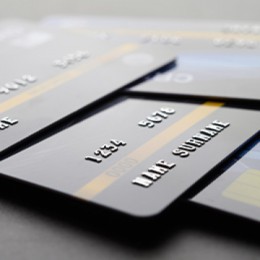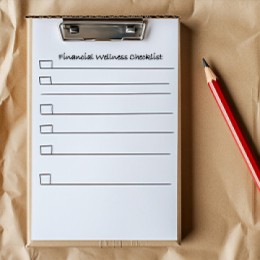
How to Create a Financial Wellness Checklist
If you’re in a place where you aren’t happy with your current finances, making a financial checklist might be a good next step to get out of your money slump. Struggling financially can lead to anxiety, stress, and overall health issues (mental, emotional, and sometimes even physical). That’s why it’s time for you to empower yourself to make good financial decisions for yourself to take charge and take a step in the right direction towards a brighter financial (and healthier) future.
Where do I begin?
Before knowing what items to list on your financial wellness checklist, it may be helpful to ask yourself a series of questions.
- Do I have an emergency fund? If yes, Am I saving enough money for emergencies?
- Am I living within my means? Or am I spending more than I make?
- Do I rely on credit cards or loans to cover basic expenses?
- What’s my credit score? Is it costing me money, and if so, how can I improve it?
- How much debt do I have? Do I have a plan for paying off debt?
- Am I prepared for major expenses? (Such as higher education, a new vehicle, or a house)
- Am I investing in my future somehow?
- How much are my retirement savings worth today? (If you have a retirement savings)
- Do I have health, life, disability, and property insurance?
- Have I set short-term, medium-term, and long-term financial goals?
- How do I feel about my financial situation?
- Do I feel stressed or anxious about money? Or am I confident and in control of my finances?
Reflecting on these questions can help you determine where you stand when it comes to your money and what your goals should be for the future. Everyone’s situation is unique, so no two checklists will look exactly alike, and this isn’t a one-time checklist. You should review it at least once a year to see if you’re still on track or if it needs to evolve as you do.
Once you have your answers, consider these steps when it comes to creating your financial wellness checklist:
Step 1: Create a Budget
- Put pen to paper or use a trustable app – start by tracking all income and expenses. Break your budget down into the 50/30/20 rule. Based on your income, allocate 50% for needs (think survival, expenses and bills) 30% for wants and 20% for savings.
Step 2: Set Financial Goals
- Establish actual, real-life money goals. Consider the short-term, mid-term, and long-term. Then be sure to evaluate those goals and adjust regularly.
Step 3: Making it Convenient, Easy and Rewarding
- When it comes to your money – why make it more difficult than it needs to be? Set up automatic transfers into savings, automate your bill payments to make sure you’re paying your bills on time (which will help improve your credit score)
- Make it convenient by using free tools like bill pay, online or mobile banking, roundup savings programs, rewards cards and more.
Step 4: Build an Emergency Fund
- Saving at least 3-6 months’ worth of living expenses can drastically help when it comes to your financial health. You’ll be less stressed and more prepared when something comes up.
- Setting up an automatic transfer to send money into an emergency fund can also be an easy way to build it up.
- Consider keeping your emergency fund in a high-yield savings account so you can earn money on your nest egg while it sits there.
Step 5: Reduce Debt
- Choose which debt repayment strategy is best for you first. The snowball method or the avalanche method. You could also ask a financial counselor what may be best for you, paying off debt with the highest rate first, or tackling debt based on the balance owed. Remember, paying your bills on time means not adding to your debt with late fees.
- More info on the Snowball and Avalanche methods can be found here: How To Manage Your Debt: Strategies & Tools
- This also may involve making cuts to your discretionary spending – which may seem like tough choices to make, but in the end, alleviating that debt burden will improve your health.
Step 6: Monitor Your Credit Score
- Check your credit report regularly for accuracy. An error on your report can cost you when it comes to your credit score.
- Work on improving your credit score by paying bills on time, reducing debt where you can, and using less than 30% of your credit limit.
Step: Plan for Major Expenses
- When it comes to your goals, if it involves large purchases in the future (e.g., home, car, education), create a plan to save for it! Give it a budget, a timeline, and an action plan. By doing this it may help you avoid financing major expenses with high-interest loans.
Step 8: Save for Retirement
- Are you already saving towards your retirement or are you not quite set up to do that yet?
- Contributing regularly to a retirement account (401(k), IRA, etc.) can make a world of difference later in life. It’s a good goal to contribute at least 10% of your income towards retirement.
Step 9: Invest Wisely
- Have you started investing? If not, why not start now? Make a well-researched and educated decision when it comes to investing. Diversify your investment portfolio and regularly review and adjust your investments to align with your goals.
Step 10: Take a look at your Insurance Coverage
- Safeguarding you and your family against life's uncertainties and ensuring long-term financial stability is one reason you should take a look at your insurance coverage.
- Considering insurance can help when it comes to protecting you against the unexpected, supporting income, preserving your savings, and providing peace of mind.
- Ensure you have adequate health, life, disability, and property insurance.
Step 11: Consider Estate Planning and Writing a Will
- Estate planning and writing a will, can help protect your loved ones, ensure your wishes are respected, and contribute to your overall financial wellness by creating a comprehensive and secure financial plan for when you’re gone.
Step 12: Increase Financial Literacy
- Continuously educate yourself about personal finance. You evolve, and your money evolves. It’s never too late to start or get a refresh for your finances.
Step 13: Review and Adjust Regularly
- Regularly review your financial wellness checklist, plan, or budget regularly and adjust as needed. Set a reminder twice a year if you have to!
It’s time to take control of your financial health, and by doing so gain improvement in your mental, emotional, and physical health too. Stay dedicated, stay on track, and strive for success!
Make checking off your financial wellness checklist a little more fun with our FINANCIAL WELLNESS BINGO CARD!











0 comments